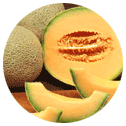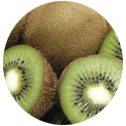 Full List of Fruits
Full List of Fruits  Acerola fruit
Acerola fruitAcerola Fruit
Scientific name - Malpighia emarginata
Acerola is a tropical fruit endemic to parts of the West Indies. Its large bushy shrub reaches just about 8-18 feet in height. Bearing attractive lavender and pink color flowers, it blossoms throughout the year and its fruits are a good source of mineral magnesium, vitamin niacin and panthotenic acid. Having said that, it also contains substantial amount of vitamin b1-thiamine and b2-riboflavin! The best part about the fruit is that they are of very less calories simply said; 100 g fresh berries provide just 32 calories.
The Acerola tree grows up to 6 meters and has a deep, spreading root system. Its leaves are oblong and have a pointed tip. The tree produces clusters of small, bright red berries, each about 1 cm in diameter. The fruit is juicy, with a sweet and sour taste and contains small seeds. Acerola is a versatile fruit that can be eaten fresh, dried, or processed into juices, jams, jellies, and other products.
Acerola is a rich source of antioxidants and vitamins, including Vitamin C, which is essential for healthy skin and immune system functioning. It is also a good source of Vitamin A, B Vitamins, calcium, magnesium, phosphorus, and iron. Acerola is known to have anti-inflammatory, antiviral, and antifungal properties. It is also believed to have the potential to reduce the risk of cancer, heart disease, and other chronic diseases. Acerola is a popular dietary supplement because of its high concentration of Vitamin C. It is available in powder, capsule, tablet, and liquid forms. It can also be found in some energy drinks, fruit juices, and health bars. The recommended daily intake of Acerola is 500 to 1,000 mg.
Believed to be originated from the Yucatan, the Acerola fruit is distributed from South Texas, through Mexico and Central America to northern South America and throughout the Caribbean. With that said, the fruit is now been productively introduced in sub-tropical areas throughout the world. In general, the Acerola is found in dry, thorn-woodlands as a deciduous tree.
The fruit is also known by several other common names like Barbados cherry, West Indian Cherry, Cereza, Cerisier, and Semeruco. With three years' time, the tree will produce significant numbers of red drupes with the size ranging from 1-3 cm (0.39-1.18 in) in diameter. It comes as a pair or groups of three with triangular seeds. With high vitamin C content, the drupes are juicy and are usually acidic to sub acidic.
| Principle | Nutrient Value | Percentage of RDA |
|---|---|---|
| Energy | 32 Kcal | 1.5% |
| Carbohydrates | 7.69 g | 6% |
| Protein | 0.40 g | <1% |
| Total Fat | 0.30 g | 1.5% |
| Cholesterol | 0 mg | 0% |
| Dietary Fiber | 1.1 g | 2.5% |
| Vitamins | ||
| Folates | 14 | 3.5% |
| Niacin | 0.400 mg | 2.5% |
| Pantothenic acid | 0.309 mg | 6% |
| Pyridoxine | 0.009 mg | <1% |
| Riboflavin | 0.060 mg | 4.5% |
| Vitamin A | 767 IU | 26% |
| Vitamin C | 1677.6 mg | 1864% |
| Electrolytes | ||
| Sodium | 7 mg | 0.5% |
| Potassium | 146 mg | 3% |
| Minerals | ||
| Calcium | 12 mg | 1.2% |
| Copper | 0.086 mg | 9% |
| Iron | 0.20 mg | 2.5% |
| Magnesium | 18 mg | 4.5% |
| Phosphorous | 11 mg | 1.5% |
| Selenium | 0.6 | 1% |
| Zinc | 0.10 mg | 1% |
Preventing heart disease.
Prevent from Cancer.
Depression
Acerola fruit is native to the tropical climates of Central and South America, where it is an important part of many diets. Acerola fruit is an excellent source of vitamin C, one of the most important vitamins for human health. It is also rich in other micronutrients such as calcium, iron, and magnesium. The acerola fruit has many health benefits, including its ability to boost the immune system, fight free radicals, and help protect against cancer. Acerola fruit can be eaten fresh or dried, and it can also be used to make jams, jellies, and sauces. It can be added to smoothies and juices to add flavor and nutrition. It can also be used to make a refreshing tea. The fruit can be used in a variety of dishes, from salads to desserts.Acerola fruit is also used in cosmetics, as it is known to have antioxidant and anti-aging properties. It is often used in face masks, cleansers, and other skin care products to help nourish and protect the skin.It can also be used as a natural dye for clothing and other fabrics.
Acerola fruit, also known as Barbados cherry, West Indian cherry, or wild crepe myrtle, is a small, red, tropical fruit that is native to the Caribbean, Central and South American.
It is a member of the Malpighiaceae family, and is closely related to the acerola tree. Acerola fruit is prized for its sweet, tart flavor and high nutrient content, making it a popular fruit in many tropical regions.Acerola fruit has been used for centuries by indigenous people in the Caribbean and Central and South America. It was first documented by Spanish explorers in the 16th century.
The fruit was originally used to make a syrup that was used to treat a variety of ailments, such as fevers and sore throats. It was also used in traditional medicine to treat dysentery, diarrhea, and other ailments. Acerola fruit is a small, round berry that grows on shrubs or small trees. The fruit has a thin skin that is red when ripe and a juicy, yellow-orange flesh. It has a unique flavor that is sweet and tart, similar to a cranberry. It is high in vitamin C and other antioxidants, making it a popular choice as a nutritional supplement in many countries. Acerola fruit is harvested in the summer and autumn months. The fruit is picked when it is ripe, and then processed within two days of harvest.
It is then dried, frozen, or juiced. The dried form of the fruit is often used in jams, jellies, and juices, while the frozen and juiced forms are used in smoothies and other drinks.In recent years, the popularity of acerola fruit has grown due to its high nutritional content. It is a good source of vitamins A, B, C, and E, as well as minerals such as calcium, magnesium, and potassium. It also contains phytochemicals such as polyphenols, which have been linked to a number of health benefits, including a reduced risk of some cancers and cardiovascular disease. Acerola fruit is increasingly being used in a variety of products, including energy drinks, sports drinks, and health supplements. It is also becoming a popular ingredient in smoothies and other food products. As its popularity continues to grow, more research is being done to better understand the health benefits of this unique fruit.


















